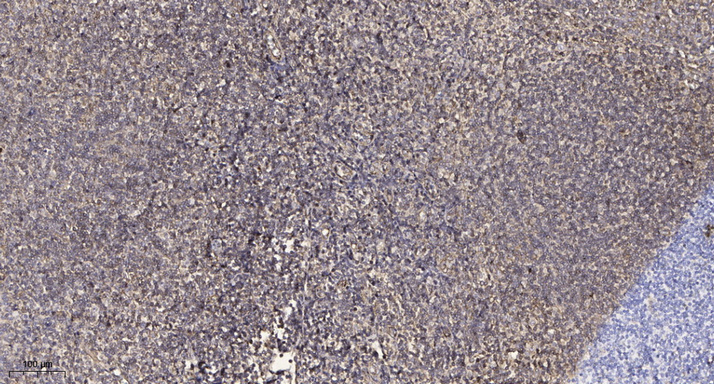PSMD3 Polyclonal Antibody
- Catalog No.:YT3890
- Applications:WB;IHC;IF;ELISA
- Reactivity:Human;Mouse;Rat
- Target:
- PSMD3
- Fields:
- >>Proteasome;>>Alzheimer disease;>>Parkinson disease;>>Amyotrophic lateral sclerosis;>>Huntington disease;>>Spinocerebellar ataxia;>>Prion disease;>>Pathways of neurodegeneration - multiple diseases;>>Epstein-Barr virus infection
- Gene Name:
- PSMD3
- Protein Name:
- 26S proteasome non-ATPase regulatory subunit 3
- Human Gene Id:
- 5709
- Human Swiss Prot No:
- O43242
- Mouse Gene Id:
- 22123
- Mouse Swiss Prot No:
- P14685
- Immunogen:
- The antiserum was produced against synthesized peptide derived from human PSMD3. AA range:351-400
- Specificity:
- PSMD3 Polyclonal Antibody detects endogenous levels of PSMD3 protein.
- Formulation:
- Liquid in PBS containing 50% glycerol, 0.5% BSA and 0.02% sodium azide.
- Source:
- Polyclonal, Rabbit,IgG
- Dilution:
- WB 1:500 - 1:2000. IHC 1:100 - 1:300. ELISA: 1:40000.. IF 1:50-200
- Purification:
- The antibody was affinity-purified from rabbit antiserum by affinity-chromatography using epitope-specific immunogen.
- Concentration:
- 1 mg/ml
- Storage Stability:
- -15°C to -25°C/1 year(Do not lower than -25°C)
- Other Name:
- PSMD3;26S proteasome non-ATPase regulatory subunit 3;26S proteasome regulatory subunit RPN3;26S proteasome regulatory subunit S3;Proteasome subunit p58
- Observed Band(KD):
- 61kD
- Background:
- The 26S proteasome is a multicatalytic proteinase complex with a highly ordered structure composed of 2 complexes, a 20S core and a 19S regulator. The 20S core is composed of 4 rings of 28 non-identical subunits; 2 rings are composed of 7 alpha subunits and 2 rings are composed of 7 beta subunits. The 19S regulator is composed of a base, which contains 6 ATPase subunits and 2 non-ATPase subunits, and a lid, which contains up to 10 non-ATPase subunits. Proteasomes are distributed throughout eukaryotic cells at a high concentration and cleave peptides in an ATP/ubiquitin-dependent process in a non-lysosomal pathway. This gene encodes a member of the proteasome subunit S3 family that functions as one of the non-ATPase subunits of the 19S regulator lid. Single nucleotide polymorphisms in this gene are associated with neutrophil count. [provided by RefSeq, Jul 2012],
- Function:
- function:Acts as a regulatory subunit of the 26 proteasome which is involved in the ATP-dependent degradation of ubiquitinated proteins.,similarity:Belongs to the proteasome subunit S3 family.,similarity:Contains 1 PCI domain.,subunit:The 26S proteasome is composed of a core protease, known as the 20S proteasome, capped at one or both ends by the 19S regulatory complex (RC). The RC is composed of at least 18 different subunits in two subcomplexes, the base and the lid, which form the portions proximal and distal to the 20S proteolytic core, respectively.,
- Subcellular Location:
- proteasome complex,nucleus,nucleoplasm,cytoplasm,cytosol,proteasome regulatory particle, lid subcomplex,membrane,proteasome accessory complex,extracellular exosome,
- Expression:
- Eye,Hepatoblastoma,Kidney,Lung,Pancreas,Skin,
- June 19-2018
- WESTERN IMMUNOBLOTTING PROTOCOL
- June 19-2018
- IMMUNOHISTOCHEMISTRY-PARAFFIN PROTOCOL
- June 19-2018
- IMMUNOFLUORESCENCE PROTOCOL
- September 08-2020
- FLOW-CYTOMEYRT-PROTOCOL
- May 20-2022
- Cell-Based ELISA│解您多样本WB检测之困扰
- July 13-2018
- CELL-BASED-ELISA-PROTOCOL-FOR-ACETYL-PROTEIN
- July 13-2018
- CELL-BASED-ELISA-PROTOCOL-FOR-PHOSPHO-PROTEIN
- July 13-2018
- Antibody-FAQs
- Products Images

- Immunohistochemical analysis of paraffin-embedded human tonsil. 1, Antibody was diluted at 1:200(4° overnight). 2, Tris-EDTA,pH9.0 was used for antigen retrieval. 3,Secondary antibody was diluted at 1:200(room temperature, 30min).



